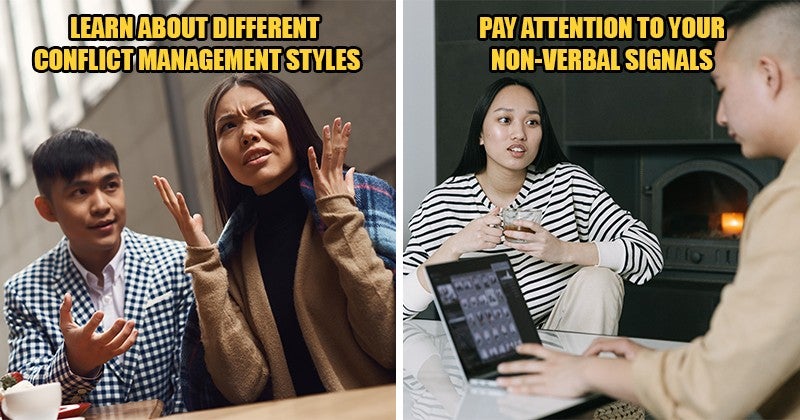Conflict is an inevitable part of every relationship, be it romantic, familial, platonic, or professional relationships. Regrettably, many Malaysians lack the essential skills to resolve conflicts and this often takes a toll on their cherished connections!
Want to enhance your conflict resolution skills and build stronger relationships? You’re at the right place! In this article, we outline some tried-and-true strategies that will empower you to address conflicts within any relationship.
1. Reflect before you react
When confronted with conflicts, our instinctive responses are usually to defend aggressively or to withdraw and freeze. Although the “fight or flight” response is a natural reaction, it hinders the progress of conflict resolution. Before diving into heated debates, consider this approach:
- Excuse yourself from the conflict environment and let the other person know when you’ll be ready for a discussion.
- Utilise your personal space to:
- Name your triggers and emotions
- Identify the reasons behind your triggers
- Choose the best responses (e.g. rephrase your words, reconsider your actions)
This practice of self-regulation empowers you to maintain control over your emotions and actions, even in the midst of challenging situations. It allows you to respond in ways that are consistent with your values!

2. Identify different responses to conflicts
The Conflict Management Model proposed by Thomas Kilmann identifies five distinct conflict management styles that people typically employ when confronted with disputes or disagreements:
- Competing: prioritise being right over preserving the relationship
- Collaborating: be assertive and cooperative in finding solutions
- Avoiding: step away from a situation to avoid conflict
- Accommodating: put the needs of others above their own to protect the peace
- Compromising: willing to sacrifice something to reach a middle ground
Each style has its own advantages and drawbacks, and their effectiveness varies according to the circumstances at hand. By understanding these styles, you get to employ the most effective resolution methods for different situations instead of turning to your typical responses.

3. Use effective communication skills
Communication is paramount when it comes to conflict resolution. Nevertheless, if handled improperly, it can elicit anger and lead to more heated arguments! If you want to foster a constructive dialogue, try incorporating these skills:
- Don’t make generalizations (e.g. saying “never”, “always”, “every time”)
- Use “I” statements when expressing yourself to avoid blame or accusations
- Actively seek feedback and clarification to prevent misunderstandings and confusion
- Ask open-ended questions instead of loaded questions to avoid assumptions and manipulation
Don’t forget to encourage the other party to adopt these communication methods too! Together, these strategies can pave the way for more effective, empathetic, and productive discussions.

4. Pay attention to your non-verbal cues
Non-verbal cues hold the power to convey messages and emotions that mere words might not express. They also influence how others respond to you! To defuse tension and facilitate communication, consider these key non-verbal elements:
- Facial expression: maintain appropriate eye contact, avoid frowning, nod to signal validation
- Body language: align your body with the other person’s, lean forward slightly with uncrossed arms and legs
- Gesture: respect personal space boundaries, employ physical touch to indicate support if appropriate
- Voice: modulate your tone and volume to ensure clear and respectful communication
By incorporating these non-verbal cues, you can effectively convey interest, honesty, and respect, thereby fostering a conducive environment for productive and harmonious discussions.

5. Practise active listening
Active listening is a profound skill that demands your full engagement in a conversation. It involves listening with the intent to understand others, rather than listening to respond. Some techniques include:
- Withholding judgements: creates a safe space for others to express their thoughts
- Being patient: give the other person the time and space to finish expressing
- Restating expressed thoughts: avoid misunderstanding what others have said
When you listen actively, you demonstrate empathy, respect, and trust, thus reducing tension and defensiveness in a conversation.

6. Seek a common ground
Some conflicts can seem insurmountable, but don’t fret! Start by seeking a common ground. Recognizing areas of agreement (e.g. shared values and common goals) is a potent negotiation approach.
It’s the first step towards generating alternatives and solutions that meet both parties’ interests. By adopting a solution-oriented mindset. you can encourage collaboration and compromise, transforming the conflict context from a “you vs. me” situation into an “us vs. the problem” scenario.

It’s crucial to note that adopting these resolution techniques doesn’t necessitate total agreement with others. Instead, they empower you to express your opinions respectfully and maturely, all while considering the thoughts and emotions of the other person!
These approaches minimise the likelihood of inflicting or experiencing hurt during conflicts, thus nurturing robust relationships that can withstand various challenges and adversities. What are your go-to conflict resolution methods? Let us know in the comments below!
Also read: Self-Diagnosing & 5 Other Common Mental Health-Related Mistakes M’sians Should Avoid




































